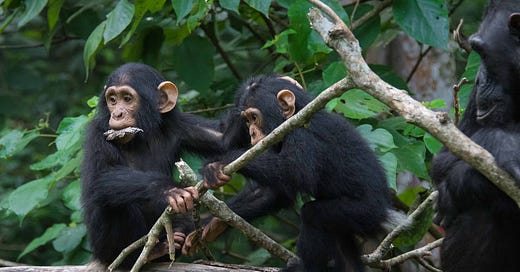Chimpanzee Gestures Mirror Human Conversational Turn-Taking, Study Finds
Research on East African Chimpanzees Reveals Sophisticated Communication Similar to Human Interactions
Humans might be the masters of quick-fire banter, but chimpanzees have their own rapid back-and-forths, albeit in the form of hand signals. Recent research1 reveals that wild chimpanzees in East Africa exhibit communication patterns remarkably similar to human conversational turn-taking.

Understanding Chimpanzee Communication
Researchers analyzed thousands of gestures made by wild chimpanzees, uncovering significant similarities to human interactions. The study, conducted by experts from the University of St Andrews, delves into the rapid responses and structured exchanges among chimps, offering insights into the shared fundamental features of communication between humans and apes.
Dr. Gal Badihi, an animal behavior expert at the University of St Andrews, highlighted the strict rules of turn-taking in human conversations and explored whether similar rules govern chimpanzee communication. She noted,
“Human conversation follows very strict rules of turn-taking that are consistent across cultures and languages. We started to wonder whether chimpanzee communication was governed by its own rules, or if the rules are similar to human conversation.”
The Rich Repertoire of Chimp Gestures
Chimpanzees possess a rich repertoire of hand gestures, many of which serve as simple requests such as "stop it," "follow me," or "groom me." To understand the rules surrounding these gestures, researchers studied over 8,500 interactions recorded from 252 wild chimps across five communities in East Africa.
Most interactions were brief, but some involved extended exchanges. For instance, at the Budongo Conservation Field Station in Uganda, a chimp named Monica extended her hand towards another chimp, Ursus, after a physical altercation, prompting Ursus to respond with a reassuring tap. In other cases, chimps traded up to seven gestures in succession, with response times averaging 120 milliseconds, comparable to the human conversational response time of 200 milliseconds.
Gestures in Everyday Chimp Life
“Chimpanzees use gestures in almost every aspect of their life…”
…explained Dr. Badihi. Besides reconciling after conflicts, chimps use gestures to avoid confrontation, greet each other with hugs or kisses, request food sharing, and indicate travel intentions. Grooming sessions, in particular, involved numerous gestures to change positions or start grooming in new areas. Badihi observed,
“Some groups use a big, loud scratch gesture and then start grooming together. In the middle of the grooming interactions, they might gesture to each other to change position or to start grooming in a new place.”
Cultural Variations and Evolutionary Implications
The study, published in Current Biology, describes how the timing between exchanges varied little between chimps of different ages but showed subtle differences between communities, akin to human cultural variations. For example, the Sonso chimp community in Uganda exchanged gestures more slowly, similar to slower conversational responders in human cultures, like the Danish.
The findings suggest that rapid turn-taking in communication may be a product of our shared evolutionary heritage with chimps. Alternatively, quick-fire exchanges could be a broader feature of social communication, potentially present in other species such as whales, dolphins, bats, and hyenas.
Conclusion
This research provides compelling evidence of the sophisticated communication systems in chimpanzees, highlighting the parallels with human conversational behavior. By understanding these shared traits, anthropologists and evolutionary biologists can gain deeper insights into the evolutionary roots of communication, offering a new perspective on the intricate social dynamics of our closest living relatives.
Badihi, G., Graham, K. E., Grund, C., Safryghin, A., Soldati, A., Donnellan, E., Hashimoto, C., Mine, J. G., Piel, A. K., Stewart, F., Slocombe, K. E., Wilke, C., Townsend, S. W., Zuberbühler, K., Zulberti, C., & Hobaiter, C. (2024). Chimpanzee gestural exchanges share temporal structure with human language. Current Biology: CB, 34(14), R673–R674. https://doi.org/10.1016/j.cub.2024.06.009



